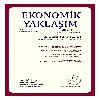Kamu borçlanması kamu yatırımlarını dışlıyor mu?
Does the public indedtment crowd out the public investment?
___
- ABU BAKAR, Nor' Aznin (2008), "Empirical EvaIuation On Extemal Debt of Malaysia", International Business & Economics Research Journal, 7 (2), 95-108.
- AÇBA, Sait (1994), Devlet Borçlanmasi, Afyon Kocatepe Üniversitesi I.I.B.F, Afyon.
- BARRO, J., Robert (1974), "Are Govemment Bonds Net Wealth?", The Journal of Political Economy,82 (6), 1095-1117.
- BLAVY, Rodolphe (2006), "Public Debt and Productivity: The Difficult Quest for Growth in Jamaica", IMF Working Paper, WP/06/235.
- CALDERON, Cesar, EASTERLY, William, SERVEN, Luis (2003), "Latin America's Infrastructure in the Era of Macroeconomic Crisis", (The Limits of Stabilization: Infrastructure, Public Deficits, and Growth in Latin America), Stanford University Pres, and The World Bank, United States.
- CHOTE, Robert, EMMERSON, CarI, TETLOW, Gemma (2008), "The IFS Green Budget'',http://www.ifs.org.uk/budgets/gb2008/indexphp, Erisim: 24/03/2010.
- CLEMENTS, Benedict, BHATTACHARYA, Rina, NGUYEN, Quoc, Toan (2003), "Extemal Debt, Public Investment, and Growth in Low-Income Countries", IMF Working Paper, WP/03/249.
- DICKEY, David, FULLER, Wayne, Arthur (1979), "Distribution of the Estimators for Autoregressive Series with a Unit Root", Journal of the American Statistical Association, 74, 427-43 i.
- DIJKSTRA, Geske, HERMES, Niels (2001), "The Uncertainty of Debt Service Payments and Economic Growth of Highly Indebted Poor Countries: Is There a Case for Debt Relief?", WIDER Conference on Debt Relief, 17- 18 August, Hel sinki .
- DUTTA, Indranil (2007), "The Burden of Govemment Debt in the Indian States; Implication for the MDG Poverty Target", World Institute for Development Economics Research, Research Paper No: 2007/14.
- ENDERS, Walter (2004), Applied Econometric Time Series, 2nd Edition, John Willey&Sons, USA.
- ENGLE, Robert, GRANGER, Clive, William, John (1987), "Cointegration and Errar Correction: Representation, Estimation and Testing" Econometrica, 55, 251-276.
- GRANGER, Clive, William, John (1969), "Investigating Causal Relations by Econometric Models and Cross-Spectral Methods", Econometrica, 137,424-438
- GRANGER, Clive, William, John (1988) "Same Recent Devolopments in a Concept of Causality", Journalaf Econometrica, 39, 199-211.
- HAMEED, Abid, ASHRAF, Hammad, CHAUDHARY, Ali Muhammed (2008), "External Debt and its Impact on Economic and Business Grawth in Pakistan", International Research Journalaf Finance and Economics, 20, 132-140.
- HEINEMANN, Friedrich (2002), "Factor Mobility, Government Debt and the Dec1ine in Public Investment", Centre for European Economic Research (ZEW) Discussion Paper, 02-19
- HELLER, Peter, S., DIAMOND, Jack (1990), "International Comparisons of Government Expenditure Revisited: The Developing Countries", IMF Occasional Paper, 69.
- HICKS, L., Narrnan (1989), "Expenditure Reductions in High-Debt Countries", Finance and Development, 26, 35-37.
- HICKS, L, Norman (1991), "Expenditure Reductions in Developing Countries Revisited", Journalaf International Development, 3 (1),29-37.
- KELLERMAN, Kersten, (2007)"Debt Financing of Public Investment: On a Popular Misinterpretation of the Golden Rule of Public Sectar Borrowing", European Journal ofPolitical Economy, 23, 1088-1104.
- KHAN, Mahmood-ul-Hasan (2004) "Defence Expenditure and Macraeconomic Stabilization: Causality Evidence from Pakistan", State Bank of Pakistan Working Papers, 2.
- KRUGMAN, Paul (1988), "Financing vs. Forgiving a Debt Overhang", NBER Working Paper Series, 2486.
- LORA, Eduardo (2007), "Public Investment in Infrastructure in Latin America: Is Debt the Culprit?", Inter-American Development Bank Working Paper, 595.
- LORA, Eduardo, OLIVERA, Mauricio (2007), "Public Debt and Social Expenditure: Friends or Foes?", Emerging Markets Review, 8, 299-310.
- MACKINNON, James .G. (1996), "Numerical Distribution Functions for Unit Root and Cointegration Tests", Journal of Applied Econometrics, 11,601-618.
- MACKINNON, James .G., HAUG, Alfred .A., MICHELIS, Leo (1999), "Numerical Distribution Functions of Likelihood Ratio Tests for Cointegration", Journal of Applied Econometrics, 14, 563-577.
- MAHDAVI, Saeid (2004), "Shifts in the Composition of Govemment Spending in Response to Extemal Debt Burden", World Development, 32(7),1139-1157.
- PATTILLO, Catherine, POIRSON, Helene, RICCI, Luca (2002), "Extemal Debt and Growth", International Monetary Fund, WP/02/69, 1-49.
- PATTILLO, Catherine, POIRSON, Helene, RICCI, Luca (2004), "What Are the Channels through Which Extemal Debt Affects Growth?", IMF Working Paper, WP/04/15.
- SEN, Swapan, KASIBHATLA, Krishna M., STEWART, David B. (2007), "Debt Overhang and Economic Growth-the Asian and the Latin American Experiences", Economic Systems, 31(1), 3-11.
- TABAN, Sami (2004) "Türkiye'de Saglik ve Ekonomik Büyüme Iliskisi: Nedensellik Testi", 3. Ulusal Bilgi, Ekonomi ve Yönetim Kongresi, Eskisehir.
- ISSN: 1300-1868
- Yayın Aralığı: 3
- Yayıncı: Ekonomik Yaklaşım Derneği
Alfred Marshall, John Maynard Keynes ve 'iktisat ile etik' ilişkisi
Kamu borçlanması kamu yatırımlarını dışlıyor mu?
Oktay Orçun BEKEN, Mehmet DURKAYA, Servet CEYLAN
Dünya enerji tüketimi:1980-2005 döneminde enerji tüketimindeki değişim
Harun ÖZTÜRKLER, A. Hakan ÇERMİKLİ
Modern ile postmodern paradigmanın cumhuriyet nosyonu üzerine etkileri
Ormanda mülkiyet hakları mücadelesi ve Orman Kanunu'nun 2/B düzenlemesi
